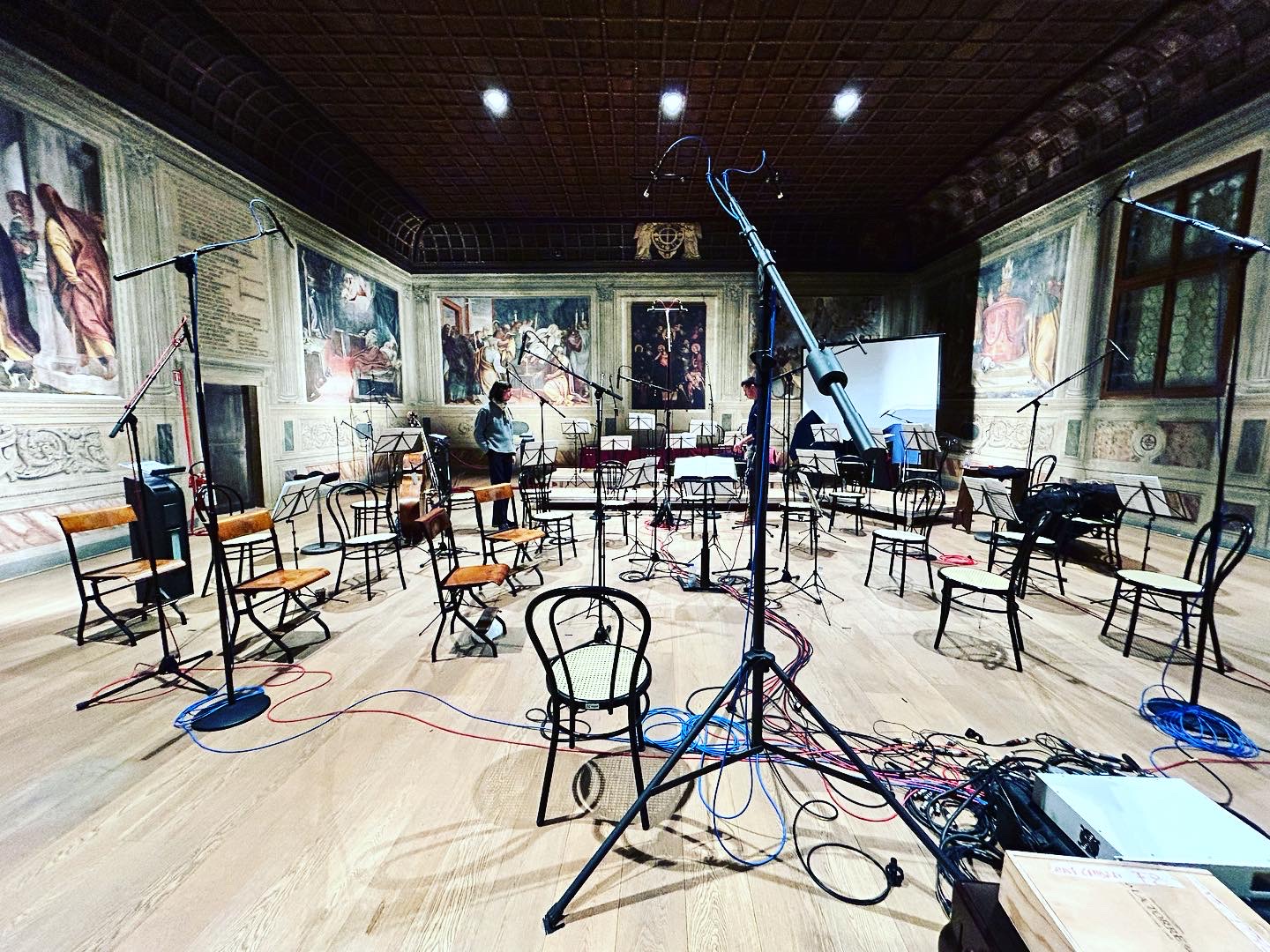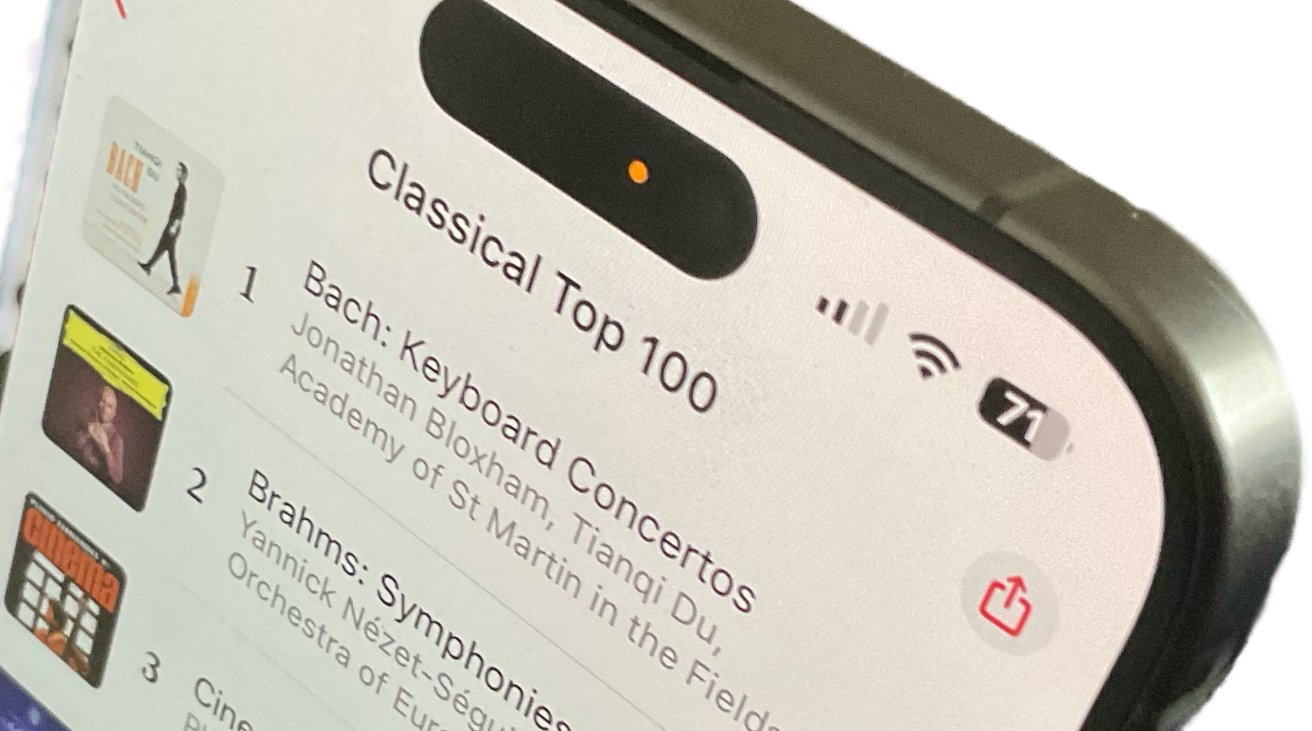To attend a recording session is to witness music created under laboratory conditions. It is an opportunity to be grabbed hold of, relished and documented.
True to form, I’m late to my appointment to listen at Sala della Carita in Padua old town. I would have arrived earlier had I planned my time a little better and inputted the right destination from Google Maps.
The embarrassing combination of an overrunning meeting, and me arriving at the wrong venue have contributed to an elevated heart rate and general state of flappiness. I finally arrive at a heavily timbered front-door breathless, where I’m invited in and given whispered instructions. I feel oddly tense. Embarrassment tinged with mild shame.
We walk slowly and quietly up the stone staircase in brief tip-toed spurts, in between takes when conductor Maxim Emelyanychev is heard sharing words of encouragement to the orchestra Il Pomo D’Oro. It’s as though I’m caught in an early rehearsal for the final sequence of Do-Re-Mi in the Sound of Music movie. Awkward movements trying desperately to be considerate.
Walking up the staircase into this sound world feels like climbing into a cloud full of sound. The stone walls, sprung wooden floor and timber ceiling that make up the interior surfaces of Sala della Carita (a building of medieval origin dedicated to supporting the poor and sick in the late 15th century) amplify Il Pomo D’Oro’s defining sound. The top end has an icy-sharp edge, the bass growls, and the edges of woodwind and brass are rounded and smooth. There is a seemingly unstoppable power driving the sound, a sound that results in a sense of solidity and strength. It’s not like any other sound I’ve heard I don’t think. Quite astonishing.

I find one of only two or three seats that don’t have an empty instrument case strewn across it (other people’s expensive and property to be avoided at all costs, in the same way, looking in mum’s handbag felt strictly off limits) and sit down and marvel.
I’m here ostensibly to observe conductor Maxim Emelyanychev as he and the band record Mozart’s Symphony 40 – the next instalment of Il Pomo D’Oro’s epic exploration of the classical composer’s output.
I’m fascinated by Maxim ever since I saw him conduct the Scottish Chamber Orchestra in an electrifying performance of Tchaikovsky’s 6th symphony in Usher Hall. The breakneck speed of the third movement made for a jaw-dropping live experience of which there was precious little warning. It was gobsmacking and electrifying and quite possibly even terrifying. One of those concert experiences that are and remain memorable. An occasion that resolutely drives a flag into the ground.
Maxim’s personality on stage was disarming that night. Gangly and boyish, he swept onto the stage with a business-like purpose suffused with an endearing child-like awkwardness. This was seemingly at odds with what we heard that night. There was strength, power and force, but also lightness. How did he achieve that? Is that disarming physicality a strategy or an accident? Did I witness a rare and brilliant live movement in Usher Hall, or is this what Maxim does? Is this his trademark? Can I get the answers to some or all of those questions just by watching him in a recording? And perhaps most pressing of all, what am I going to ask him given that I am (let’s be completely honest) clearly a fanboy.

There are elements in Maxim’s work which are an event in Il Pomo’s recordings and evident this afternoon. The first release in the Mozart exploration is a ravishing recording of Mozart’s Piano Concerto No. 23. The string section glides, bounces and bruises, the woodwind is sweet and warm. When the solo line in the piano kicks in there’s industry with an unexpectedly human-sounding mechanical edge. Texturally it’s a complete sound made up of perfectly selected contrasts you’d never think to put together. Not unlike the Beach Boys Pet Sounds in that respect. The second movement adagio is devastatingly beautiful.
That it’s possible to hear all of these details and consistently feel the way I do every time I listen to the recording might not solely be down to the band and the soloist but also to do with sound production and the balances arrived at in the final mix. The microphones pick up the detail of each individual texture combining everything into an irresistible Michelin star recording.
Nonetheless, time spent in close proximity watching Emelyanchev’s conducting technique is worth the flight, bus and train to Padua because it illustrates how the sound production reflects the conductor’s love of sound and how he uses a dizzying array of gestures.
Dressed in a loose-fitting jumper, his characteristic long hair gives the impression he’s just escaped from a downpour. His tall frame means he’s always reaching down, right knee slightly bent, so his hand direction is visible by the players at eye level. In this way he bounces up and down with ease and grace, conveying a sense of sprightliness. There’s no danger we’ll get bogged down; everyone is constantly moving forward. Even when score demands an emphatic accent, a demonstrative foot is placed assertively but gently on the floor. He makes no sound when he does but even the microphone stands obediently shakes in response.
At other times he’s deploying big sweeping gestures that reach from way below the music stand. The line extends outwards as he extends long outstretched arms followed by fingers that awkwardly reach for something. Elsewhere he’ll lightly flick his fingers in anticipation of a soloist’s ornamentation like he’s dusting flour in preparation for some pastry he’s about to work on. And when he turns back pages in the score in readiness for another take he’ll step back from the stand with an excited jump like he’s performed a magic trick.
This gesture-led approach is utterly absorbing to watch: conducting for the musician and the nerds in the front seat. The kind of conducting that makes you want to stand up and conduct yourself. (Don’t worry. I didn’t.)

After the recording session in a nearby restaurant me and Maxim sit down for an interview. It is the first interview I’ve done in what feels like months and I’m nervous. I want to ask him questions about what he and Il Pomo D’Oro create and what they do that are impossible to answer. And I’m a fan. And fans are the worst to ask questions.
We start reflecting on the Scottish Chamber Orchestra concert that featured Tchaik 6.
“I love them so much,” Maxim says gently reaching for his words, “I am very proud of them. They can play so much different music. So many different styles. This flexibility is so important. And when you perform such big pieces like Tchaikovsky’s Sixth I find you have to be very careful about the impact otherwise the little instrumental details will be lost. If you allow the little details like that in the string section you end up hearing the score differently. You don’t need to force the wood solos to play louder, for example.”
This attention to detail carries with it enormous responsibility, surely? “The most important thing is,” he responds quickly fiddling with his table napkin, “to be honest about what you want to do. By being honest you can be free to do whatever you want to do and to be aware when something is not as you want it. My first conducting teacher said, ‘ if you do not believe what you do they will not play like you want them to play. If you are not sure, they will not be sure. But if you are 100% sure they will do whatever you want’.”
That sense of self-assuredness and assertiveness is evident in what I’ve seen today up close, but still there’s a sense that he’s collaborating with the players, a kind of co-creation. “Absolutely. When musicians are free to speak say like in a solo or if they have an idea that is definitely much better then you accept their ideas. The difficult part is to combine all of these ideas to create a unique interpretation.”
Soon after his meal arrives, I cack-handedly move on to the precison I’ve heard in the orchestra both in the album release and the session earlier in the evening. Mozart’s music in particular yields opportunity to extract detail it seems. “In Bach, Mozart’s and Schubert’s writing you have to find a lot more details in the score to do with dynamics, intention between notes, phrasing and structure. Our job is to find this and show it to the public. And I think what Pomo O’Doro’s work with singers helps us play this detail better – our work with the voice helps bring this detail out.”
A little time after the end of the interview, Maxim settles his bill and grabs his coat. For a split second, it’s like the end of lessons and playtime beckons. As he departs the restaurant with all the warmth and enthusiasm he displayed when we met earlier in the evening, everything falls into place. There are some artists who are a mass of apparent contradictions, the sum total of which has a tendency to result in considerable impact.
In Maxim’s case, it’s an endearing sense of naivety, self-assuredness and energy that has in the past few hours secured my attention. But it’s a combination that triggers an unusual protective instinct in me – as though he is someone I feel a responsibility to protect at the same time as celebrate. I felt the same way when I met pianist Daniil Trifonov in Verbier and cellist Jonathan Swensen. A weird experience given that all of these individuals are perfectly capable of taking responsibility for themselves.
I return from Italy looking forward to the end of this year when Il Pomo D’Oro’s second album will be released. I cannot wait to hear it and the remainder of the recordings too.



